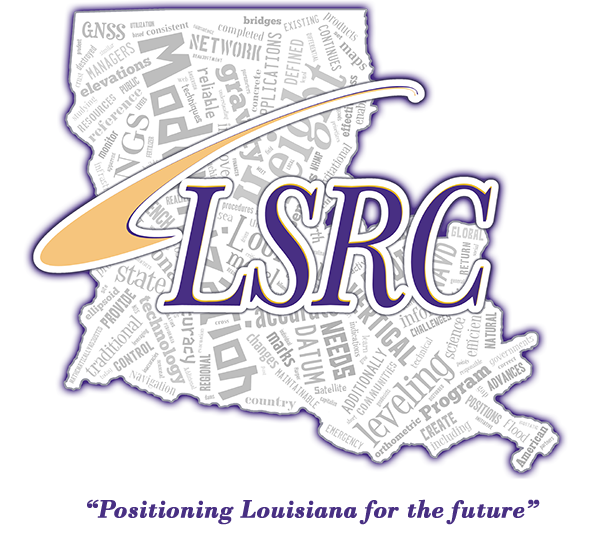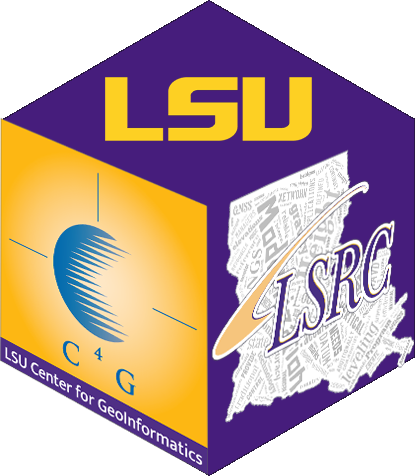 In 2001, LSU’s College of Engineering created a Center for GeoInformatics (C4G) to build new research and services in Geodesy and GeoInformatics. The National Oceanic and Atmospheric Administration (NOAA) in its 2001 report to Congress said ”Problems with historic surveys, land movement, and sea level rise have made the current vertical geodetic control in Louisiana obsolete, inaccurate, and unable to ensure safety.” In the wake of this report Professor and Researcher Roy K. Dokka, Ph.D., founding executive director of LSU’s C4G, secured funding from Congress to help NOAA fix Louisiana’s elevation problem and study the causes of 20th century subsidence.
In 2001, LSU’s College of Engineering created a Center for GeoInformatics (C4G) to build new research and services in Geodesy and GeoInformatics. The National Oceanic and Atmospheric Administration (NOAA) in its 2001 report to Congress said ”Problems with historic surveys, land movement, and sea level rise have made the current vertical geodetic control in Louisiana obsolete, inaccurate, and unable to ensure safety.” In the wake of this report Professor and Researcher Roy K. Dokka, Ph.D., founding executive director of LSU’s C4G, secured funding from Congress to help NOAA fix Louisiana’s elevation problem and study the causes of 20th century subsidence.
Subsidence is the underlying culprit behind Louisiana's most insidious environmental problem: the continuing loss of our coast. In addition to being a world-class scientific topic, coastal land loss robs the State of 25-35 square miles per year due to both natural and man-made causes. Subsidence has also had the serious effect of disturbing the system of reference markers we use for surveying the elevations of levees, evacuation routes, coastal restoration efforts, etc.
In 2002 the Center for GeoInformatics in cooperation with NOAA’s National Geodetic Survey (NGS), founded the Louisiana Spatial Reference Center (LSRC) as a partnership focused on creating state-of-the-art positional infrastructure for the state of Louisiana and to provide technical leadership, training and access to positional data. Through a grant from NOAA, LSRC installed a network of high precision Global Positioning System (GPS) receivers used as reference stations throughout Louisiana, by 2005 the network had grown to 40 stations state-wide.
This network of GPS continuous operation reference stations (CORS) was used to re-establish the official federal reference system within the state. Louisiana State Legislator made LSRC’s CORS network the vertical control standard for Louisiana in 2006 with Act 194, Section 1.R.S. 50:173.1.
LSRC’s statewide network has grown to over 100 Continuously Operating Reference Stations (CORS), 31 of which provide the raw data needed to tie Louisiana into the National Spatial Reference System (NSRS) which is defined and managed by the National Geodetic Survey (NGS). The NSRS is a consistent national coordinate system that specifies latitude, longitude, height, scale, gravity, and orientation throughout the Nation, as well as how these values change with time.
This infrastructure is currently the backbone for surveying in Louisiana, as well as supporting all GIS development, detailed topographic mapping, precision farming, navigation, and other location based applications. Long term data collection from and analysis of the data collected by LSRC’s CORS infrastructure is used to improve weather, geoid, storm surge, flood, subsidence and other scientific models as well as Height Modernization efforts along the entire Northern Gulf Coast.
C4G researchers use this system to focus their research on identifying the location of subsidence and measuring how fast the coast is sinking from place to place. Subsidence in Louisiana makes the roads more likely to flood. LSRC's efforts in Height Modernization help to predict how much flooding certain areas will experience before a storm even begins. Accurate heights alert safety planners to storm evacuation routes that are slowly sinking and susceptible to storm surges.
Committed to making transportation and navigation safer, LSRC assists NGS in conducting aerial photography surveys and elevation surveys of Hurricane Evacuation routes. LSRC also assists NGS in mapping the coastal regions of Louisiana and provides data for navigational charts. Accurate heights also provide ships with safe under-keel and overhead clearance to avoid dangerous collisions. Data from this infrastructure also provides the needed information to support present and future coastal restoration efforts.
While CORS in Louisiana were originally funded by earmarked research grant funds awarded to C4G in its role as the LSRC under the direction of Dr. Roy K. Dokka, over time earmarked funding fell out of political favor and started to dry up by the time C4G launched its Real Time Network in 2007. Users of C4G's self-funded Real-Time Network started demanding services not compatible with the LSRC funded CORS; meeting these demands required C4G to replace all of the LSRC funded CORS with reference stations that had a cost that was 400% more than the ones they replaced. Revenue generated from C4G’s value added RTN services funded not only the replacement of all of the LSRC funded CORS infrastructure but also paid for the ongoing operations of C4G. This included keeping up with the evolution of the hardware & software that makes the RTN possible as well as funding the addition of new features, tools, updates & maintenance of both the RTN and CORS infrastructure.
On August 1, 2011 Dr. Roy K. Dokka passed away unexpectedly leaving his remaining LSRC research obligations to C4G staff to finish up. Although no funding for LSRC was available, C4G continued to honor its LSRC partnership with NGS by providing free access to all CORS data in Louisiana for NGS to redistribute through their CORS website and FTP servers. In 2013 LSRC was awarded a grant as part of a Northern Gulf of Mexico multi state consortium. While some of the funds from this Height Modernization grant went into a handful of GULFNet CORS collocated on tide gauges, the majority of the CORS remained self-funded by C4G.
The LSU College of Engineering has a clear understanding of C4G’s value to its constituents and partners, as well as a definitive commitment to continued success and expansion of the Center for GeoInformatics.
